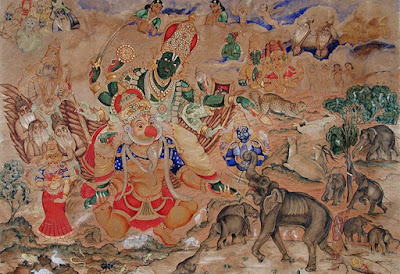Devotion and Contemporary Art in India- part 2
Devotion and Contemporary Art in India
Bhakti in Contemporary Art
Contemporary
does not mean only the art of today but it is related to the generations who
contributed their art in the past which belong to the present.
Modern art
in western countries was born around the 14th century and in India from the
19th century after Raja Ravi Varma: there was a revolution in the world of
painting
Printing presses were established and images
of God and Goddess were accessible to the common people.
With the
Swadeshi movement gaining momentum by 1905, Indian artists attempted to revive
the cultural identity suppressed by the British, rejecting the Romantic style
of the Company's paintings and the attitudes of Raja Ravi Varma and his
followers. It is thus known as the Bengal School of Art, led by the Asian
styles (with an emphasis on Indian nationalism) of Abanindranath Tagore
(1871–1951), known as the father of modern Indian art. Other artists of the
Tagore family, such as Rabindranath Tagore (1861–1941) and Gaganendranath
Tagore (1867–1938), as well as early 20th-century artists such as Amrita
Sher-Gil (1913–1941), introduced the Western Styles in Indian Art.
After that came the time of modern art in the
field of art. During these artists like M.F. Hussain, Tyab Mehta, Manjit Baba
and others came to take devotion to a different level in art. He pulled them
off differently and presented his own unique style.
After that, in the contemporary world, came
Ganesh Payne, Atul Dodiya and other artists who presented images of God with
different views.
In 1947,
India became independent from British rule. A group of six artists - K.H.Ara,
S.K.Bakre, H.A. Gade, M.F. Hussain, S.H. Raza and Francis Newton Souza -
founded the Bombay Progressive Artists Group established new ways of expressing
India in the post-colonial era. Although the group was disbanded in 1956, it
had a profound influence in changing the idiom of Indian art. In the 1950s
almost all the leading artists of India were associated with the group. Manushi
Dey, V.S. Gaitonde, Krishna Khanna, Ram Kumar, Tyab Mehta, K.G. Subramaniam, A.
Ramachandran, Devendra Singh, Akbar Padamsee, John Wilkins, Himmat Shah and
Manjit Bawa are some of the famous people of today. There is so much diversity
in Indian art today as never before. The most famous artists of the new
generation include Bose Krishnamachari and Bikash Bhattacharya. Another
prominent Pakistani modernist was Ismail Gulgee, who after Circa 1960 adopted
an abstract phrase that combines aspects of Islamic calligraphy with an
abstract expressionist (or gesture abstractionist) sensibility.
Painting and
sculpture remained in importance in the second half of the twentieth century,
although they often found new directions in the work of prominent artists such
as Nalini Malani, Subodhgupta, Narayanan Ramachandran, Jitish Kallat, Vivan
Sundaram. Bharti Dayal has chosen to handle the traditional Mithila painting in
the most contemporary way and using her imagination has created her own style,
they appear fresh and unusual.
The word
contemporary has a broad meaning. Art and artists have always been influenced
by devotion since the last 16th century. And we find that Krishna, Shiva and
Lord Rama are being accepted as the guiding sources of the Indian art of Bhakti
movement. Painting and sculpture are widely influenced by the Bhakti movement
in our country from north to south and south to west. We find Krishna as the centre
of the Bhakti movement in Indian culture and art.
It is not
about any religion; it is a complete surrender of oneself to which it is not
important. When you are overwhelmed and want to express yourself, you need A few
words or lines, colors to express, although God is formless, still, He has also a positive form. Many times artist describes Him as figurative or
sometimes as formless. This is a great journey inward.
According to
Roger Fry (an English painter and critic) in his famous Critical and
Speculative Essays on Art - “Transformations", '' how something is
represented is more important not what is represented.”
Though being
an artist, in my view art and devotion are similar, yet they differ only in
certain practices as per aspiration. So there is this journey of knowing
oneself through art from beginning to end and this is what is called Bhakti in
art.








Comments
Post a Comment